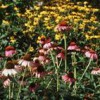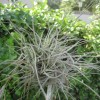 The key to enhancing wildlife (and attracting it to your property) is to provide the resources wildlife need. This means supplying food, water, and cover within the space you own and manage. Because the needs of each wildlife species for food and cover vary from one season to the next, a mix of plant species is required to meet the needs of a species all year round. And because each species has different needs, attracting and maintaining a wide variety of wildlife year round requires a wide diversity of plants. A property owner interested in attracting wildlife should nurture a wide variety of native plants to ensure that there is a large assortment of food and cover options available all the time. This 8-page fact sheet was written by Holly K. Ober and Gary W. Knox, and published by the UF Department of Wildlife Ecology and Conservation, October 2013.
The key to enhancing wildlife (and attracting it to your property) is to provide the resources wildlife need. This means supplying food, water, and cover within the space you own and manage. Because the needs of each wildlife species for food and cover vary from one season to the next, a mix of plant species is required to meet the needs of a species all year round. And because each species has different needs, attracting and maintaining a wide variety of wildlife year round requires a wide diversity of plants. A property owner interested in attracting wildlife should nurture a wide variety of native plants to ensure that there is a large assortment of food and cover options available all the time. This 8-page fact sheet was written by Holly K. Ober and Gary W. Knox, and published by the UF Department of Wildlife Ecology and Conservation, October 2013.
http://edis.ifas.ufl.edu/uw384
Tag: Native Plants
Spanish Moss, Ball Moss, and Lichens – Harmless Epiphytes
 Epiphytes are “air” plants that survive on moisture and nutrients in the atmosphere. Several epiphytic plants, like Spanish moss, ball moss, and lichen, are common to the Florida landscape and southeast United States. People unfamiliar with epiphytes sometimes worry that they may cause injuries to the plants they perch in. Epiphytes do attach themselves to plants, but they do not harm the plants, unlike mistletoe, a plant parasite. Without soil as a source of nutrients, epiphytic plants have evolved the capacity to obtain minerals dissolved in water that flows across leaves and down branches. This 3-page fact sheet was written by Joe Sewards and Sydney Park Brown, and published by the UF Department of Environmental Horticulture, September 2013.
Epiphytes are “air” plants that survive on moisture and nutrients in the atmosphere. Several epiphytic plants, like Spanish moss, ball moss, and lichen, are common to the Florida landscape and southeast United States. People unfamiliar with epiphytes sometimes worry that they may cause injuries to the plants they perch in. Epiphytes do attach themselves to plants, but they do not harm the plants, unlike mistletoe, a plant parasite. Without soil as a source of nutrients, epiphytic plants have evolved the capacity to obtain minerals dissolved in water that flows across leaves and down branches. This 3-page fact sheet was written by Joe Sewards and Sydney Park Brown, and published by the UF Department of Environmental Horticulture, September 2013.
http://edis.ifas.ufl.edu/ep485
Identification of Poison Ivy, Poison Oak, Poison Sumac, and Poisonwood (ENH886/EP220)
 Florida parks and woodlands are favorite places for many people who enjoy outdoor activities. Unfortunately, the native plants poison ivy, poison oak, poison sumac, and poisonwood can make these outings a miserable experience. All four contain urushiol, a plant oil that can cause a severe skin rash (dermatitis) when any part of the plant is contacted. Allergic reaction can occur directly by touching the plant or indirectly by coming into contact with the oil on animals, tools, clothes, shoes, or other items. Even the smoke from burning plants contains oil particles that can be inhaled and cause lung irritation. This 6-page fact sheet helps individuals learn to identify these plants in order to avoid contact with them. Children should be taught to recognize these plants, particularly poison ivy, as it is by far the most common. Written by Sydney Park Brown and Patricia Grace, and published by the UF Department of Environmental Horticulture, March 2012.
Florida parks and woodlands are favorite places for many people who enjoy outdoor activities. Unfortunately, the native plants poison ivy, poison oak, poison sumac, and poisonwood can make these outings a miserable experience. All four contain urushiol, a plant oil that can cause a severe skin rash (dermatitis) when any part of the plant is contacted. Allergic reaction can occur directly by touching the plant or indirectly by coming into contact with the oil on animals, tools, clothes, shoes, or other items. Even the smoke from burning plants contains oil particles that can be inhaled and cause lung irritation. This 6-page fact sheet helps individuals learn to identify these plants in order to avoid contact with them. Children should be taught to recognize these plants, particularly poison ivy, as it is by far the most common. Written by Sydney Park Brown and Patricia Grace, and published by the UF Department of Environmental Horticulture, March 2012.
http://edis.ifas.ufl.edu/ep220
WEC284/UW329 Conservation Subdivision: Construction Phase – Native Landscaping Palette
WEC284, a 9-page illustrated fact sheet by Mark Hostetler and Martin B. Main, discusses the importance of emphasizing native plants when selecting a landscape palette. Includes references. Published by the UF Department of Wildlife Ecology and Conservation, May 2010.
http://edis.ifas.ufl.edu/uw284